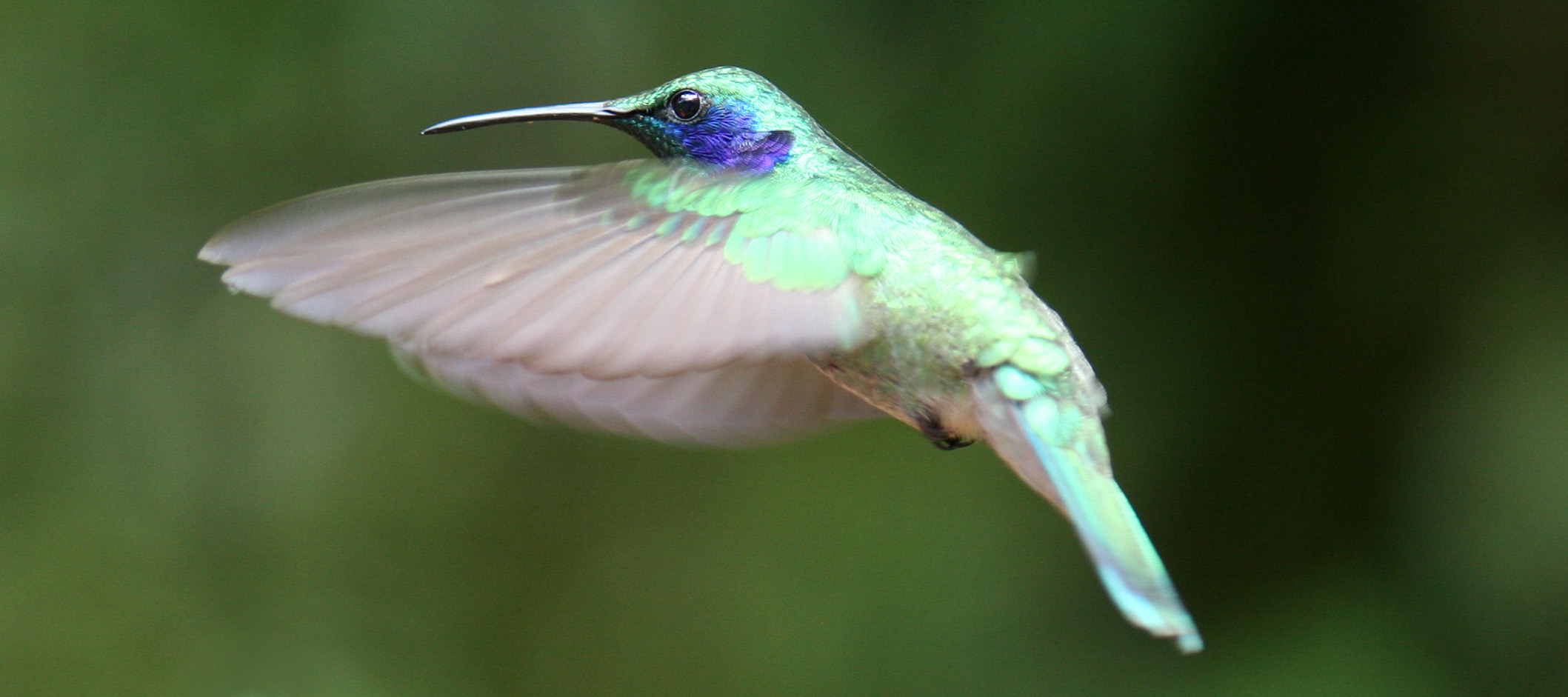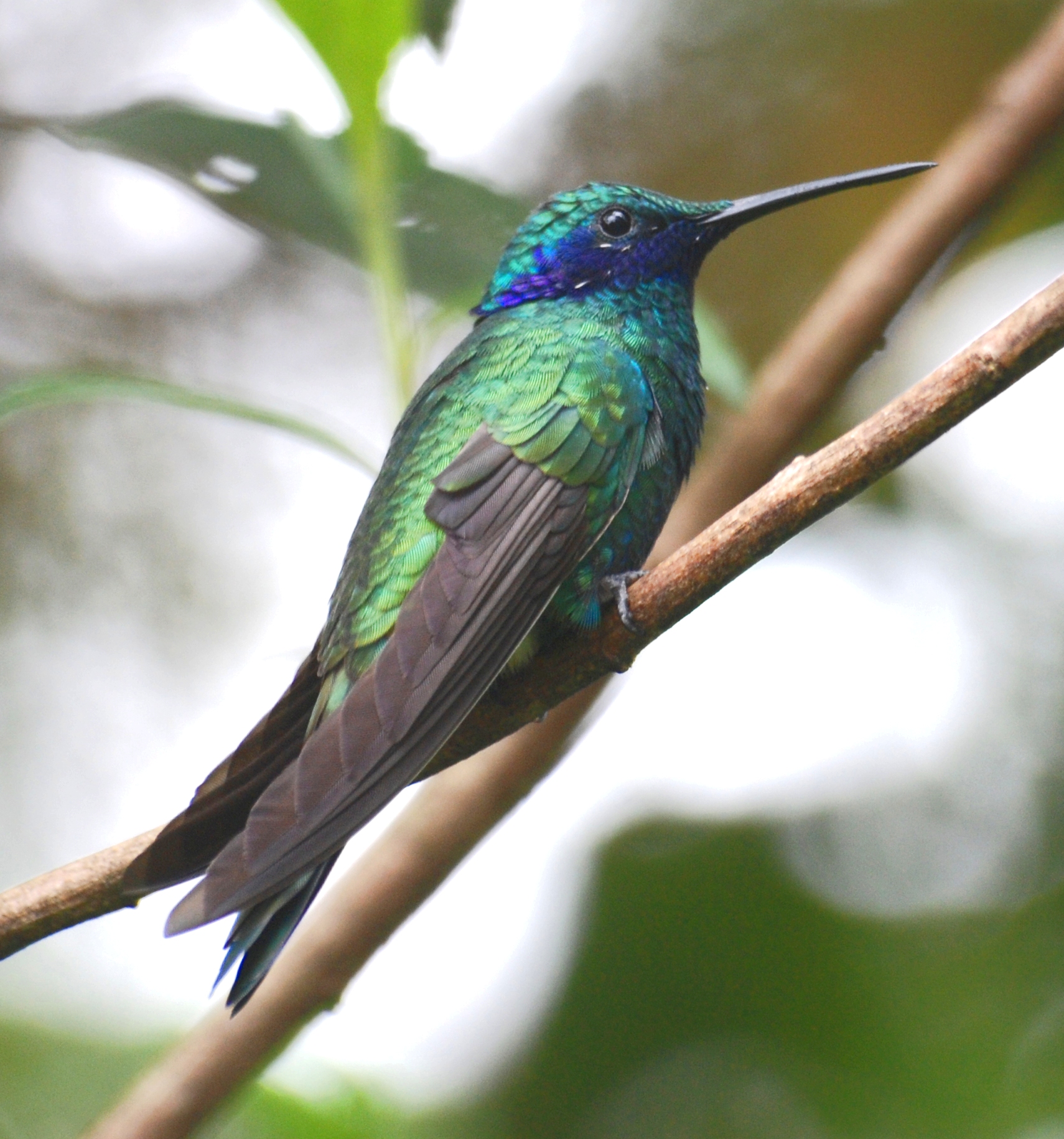The violetears are hummingbirds of the genus Colibri. They are medium to large species found in Mexico, and Central and northern South America. The Green Violetear occasionally wanders as far north as the United States and even Canada.

Violetears have ample rounded tails and short or medium black bills. Three of the four species have a mainly green plumage. The males have a violet blue patch running back and down from the eye, which is erected when they are excited, and a glittering throat patch. The female plumage is generally like the male’s, but the ear and throat patches are smaller.
Violetears build substantial cup nests into which two white eggs are laid. They have loud persistent songs, often repetitions of double notes.
These birds come readily to artificial nectar feeders, and show no fear of humans. They are aggressively territorial, and at feeders or flowering shrubs they spend much time chasing other hummingbirds, rather than feeding.
Brown Violetear
 The Brown Violetear (Colibri delphinae) is a large hummingbird that breeds at middle elevations in the mountains in Central America, and western and northern South America (primarily the Andes and the Tepuis) with isolated populations on Trinidad and in the Brazilian state Bahia.
The Brown Violetear (Colibri delphinae) is a large hummingbird that breeds at middle elevations in the mountains in Central America, and western and northern South America (primarily the Andes and the Tepuis) with isolated populations on Trinidad and in the Brazilian state Bahia.
The breeding habitat is forest at altitudes between 400-1600 m, but the Brown Violet-ear will spread widely into the lowlands when not nesting. It is replaced at higher altitudes by its relative, the Green Violetear (C. thalassimus), but their ranges overlap widely.
The Brown Violetear is typically found high in the canopy of the rainforest, tall second growth and coffee plantations, but it will feed at lower levels at edges and clearings. The nest is a small cup of plant down saddled on a twig 1-3 m. high in a bush, into which two white eggs are laid.
The 11.5 cm long, 6.5-7 g weight Brown Violetear is unmistakable; it is mainly dull brown, with a rufous rump and greyer underparts. There is a violet patch running back and down from the eye, a hermit-like malar stripe, and a glittering green and blue throat stripe. The bill is relatively short and almost straight.
The female is similar to the male, but has a smaller throat patch. Immature bird have rufous fringes to the upperpart plumage, and little or no violet behind the eyes. The song is a vigorous repetition of the chit call, and is delivered by up to several dozen breeding males in loose leks.
The Brown Violetear feeds on nectar from small flowers of trees and epiphytes. It also takes insects, often caught in flight (hawking), as an essential source of protein. Although not particularly territorial, this species is highly aggressive, and at feeders seems to spend far more time attacking other hummingbirds than actually feeding.
Green Violetear
 The Green Violetear (Colibri thalassinus) is an attractive hummingbird that is a resident breeder in highlands from south-central Mexico, (the Trans-Mexican Volcanic Belt), to western Panama and in the Andes from northern Venezuela to Bolivia. It shows seasonal movements and wanders to the United States and even Canada.
The Green Violetear (Colibri thalassinus) is an attractive hummingbird that is a resident breeder in highlands from south-central Mexico, (the Trans-Mexican Volcanic Belt), to western Panama and in the Andes from northern Venezuela to Bolivia. It shows seasonal movements and wanders to the United States and even Canada.
The male Green Violetear is grass green above and becomes a bronze color on the rump and uppertail coverlets and is 11 — 11.5 cm (4.25 — 4.5 in) in length. The tail is square and slightly notched with a broad dark blue subterminal band. The northern nominate subspecies has a large violet central breast spot on the upper breast and a violet-blue band along the chin that often connects to the violet-blue "ear", giving the bird its name. The female is similar to the male, but averages smaller and slightly duller, with a narrower violet band on the chin. The remaining subspecies (from Costa Rica and southwards) lack the violet breast spot and chin, but retain the violet-blue "ear". The juvenile is a much duller version of the adult. Its plumage is generally olive green overall with dull gray wash to the underparts. The violet breast spot is either indistinct, incomplete, or absent. A molting juvenile may show bright metallic color in patches, particularly on the throat or bre@st.
The habitat is semi-open upland country with trees and scrubs. In South America, it generally prefers more humid habitats (e.g. edge of cloud forest) than the similar Sparkling Violetear, but the two can sometimes be seen together. The nest is a substantial cup of plant material 1-3m high in a tree, into which two white eggs are laid.
The Green Violetear's song is a vigorous CHEEP-chut-chut, chip CHEET which is repeated interminably through the day. The call a dry chut. These birds visit flowers of many species of herbs, trees and scrubs for nectar.
Sparkling Violetear
 The Sparkling Violetear, Colibri coruscans, is a species of hummingbird. It is widespread in highlands of northern and western South America, including a large part of the Andes (from Argentina and northwards), the Venezuelan Coastal Range and the Tepuis. It occurs in a wide range of semi-open habitats, even in gardens and parks within major cities such as Quito, and is often the commonest species of hummingbird in its range. It is highly vocal and territorial. It resembles the smaller Green Violetear, but that species generally prefers more humid habitats and lacks the distinct purple-blue chest-spot and chin of the Sparkling Violetear.
The Sparkling Violetear, Colibri coruscans, is a species of hummingbird. It is widespread in highlands of northern and western South America, including a large part of the Andes (from Argentina and northwards), the Venezuelan Coastal Range and the Tepuis. It occurs in a wide range of semi-open habitats, even in gardens and parks within major cities such as Quito, and is often the commonest species of hummingbird in its range. It is highly vocal and territorial. It resembles the smaller Green Violetear, but that species generally prefers more humid habitats and lacks the distinct purple-blue chest-spot and chin of the Sparkling Violetear.
White-vented Violetear
 The White-Vented Violetear (Colibri serrirostris) is a species of hummingbird in the Trochilidae family. It is found in Argentina, Bolivia, Brazil, and Paraguay. Its natural habitats are subtropical or tropical dry forests, dry savanna, and heavily degraded former forest.
The White-Vented Violetear (Colibri serrirostris) is a species of hummingbird in the Trochilidae family. It is found in Argentina, Bolivia, Brazil, and Paraguay. Its natural habitats are subtropical or tropical dry forests, dry savanna, and heavily degraded former forest.
Source: Wikipedia.org










0 коментара :
Post a Comment